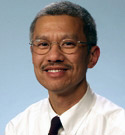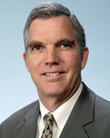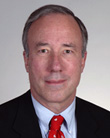Context
In February 2008, the Maine Medical Center (MMC) and the Tufts University School of Medicine (TUSM) formally embarked on a new and exciting partnership. This long-term relationship was forged to address rural workforce shortages in Maine and to provide access to medical education, but is also serving the interests of stakeholders for both institutions. This article describes the drivers and process for change, the components of this model program, and the lessons learned to date. We hope the latter will be particularly useful for individuals at other academic institutions exploring similar partnerships.
Issues
Like many other US states, Maine is also facing a growing workforce shortage. There are 3140 practicing allopathic physicians in Maine1. Data compiled by the WWAMI Rural Health Research Center indicated there were 184 Maine rural physicians per 100 000 population in 2000; of these 88 were generalist physicians2. No formal workforce study has been completed. However, the Maine Recruitment Center, which serves the Maine Hospital Association, has had over 200 physician openings for several years3. Maine's physician population is also aging, and Maine's physician workforce needs are not only in primary care but also in specialty care. Not surprisingly, physicians are needed in the southern as well as the northern regions of the state. To meet its clinical and educational missions, MMC senior leadership recognized the need to develop a different and more sustaining approach to address this growing physician shortage. The MMC leadership also embraced the notion of MMC's civic responsibility as a private, non-for-profit medical center in participating in regional education. The MMC Board of Trustees also had a sense of responsibility for improving the healthcare workforce, recruitment and retention of physicians, support of community, regional hospitals, and access to an affordable medical education for Maine students. A public-private partnership between the State of Maine and MMC developed where the State was willing to provide scholarship funds while MMC provided significant operating and capital funds and the administrative infrastructure to support the program.
Maine is a predominantly rural state with 11 of 16 counties with populations of 20 000 or less. Patients often must travel long distances to receive care in the two metropolitan areas of Portland and Bangor. The median state household income of $48 4814 reflects the challenging socioeconomic conditions that exist for Maine citizens. Maine also ranks near the bottom for medical students matriculating at allopathic medical schools5.
The MMC is the largest tertiary-care hospital in Maine. With 637 beds, MMC has a longer than 50 year tradition of being involved in both undergraduate (UME) and graduate medical education (GME). With education as one of its three core missions, MMC supports 17 residency and fellowship programs with over 200 residents. The MMC hosts over 60 students at any one time completing either third- or fourth-year rotations. Typically medical students only spend 1-2 months rotating at MMC. There are over 600 active medical staff with faculty appointments at the University of Vermont College of Medicine. In 1991, MMC established the Maine Practice Network (MPN) so that medical students in need of clerkships and residents in need of rural rotations could spend one-month rotations in over 25 clinical sites spread across rural Maine.
The TUSM is a private institution founded in 1893. The school has almost 4000 faculty (>1000 fulltime basic science and clinical), more than 1000 trainees in sponsored residency and fellowship programs, and approximately 700 medical students. The TUSM students perform core clerkships and other clinical rotations at 6 major and 15 additional affiliated teaching hospitals. Approximately 12-16% of students spend their entire third year at the Western Campus of TUSM located at Baystate Medical Center in Springfield, Massachusetts. The TUSM underwent a very successful Liaison Committee for Medical Education accreditation visit in 2006. Nevertheless, the changing face of medicine stimulated discussion for curricular reform. In response, an Educational Task Force produced recommendations that ultimately led to a new curricular plan implemented in August 2009. Between 1930 and 1980 special funding programs allowed TUSM students to work at MMC and other hospitals in Maine. During this time MMC was a major teaching affiliate for TUSM. Currently more than 300 TUSM-educated physicians live in Maine with many still engaged in active practice.
One of the best predictors for a physician practicing in a particular state or rural area is the origin of one's formative childhood years6. With Maine ranking as one of the lowest states in the US for applicants to allopathic medical schools, this program hopes to provide more access for qualified Maine students to pursue this professional career. We also wanted to address the growing debt burden of graduating medical students, expecting that such large debt obligations would impact students' choices about specialty and eventual practice location7. We sought to provide an education cost for students comparable to 'in-state' tuition for a Maine resident. Finally, TUSM wished to respond to the societal imperative to train more physicians, especially those pursuing a career in primary care8.
Establishing a new medical student education program allowed us to pursue the third major driver for change, namely, the need for curricular innovation. Medical educators at both MMC and TUSM recognize that traditional, in-patient oriented medical education, particularly in the clerkship years, may no longer provide the optimal educational environment for some students especially those interested in rural medicine and primary care. Cutting-edge curricular themes are required for physicians of the future. The TUSM began a major curriculum reform in 2007, so the timing was favorable to explore themes, which might be specific for a Maine-based curriculum.
A fourth reason to pursue a new relationship between our institutions was the desire for increased collaboration in the clinical and research arenas. Both MMC and TUSM have outstanding research infrastructures and capabilities (the MMC Research Institute, and the Sackler School of Graduate Biomedical Sciences, respectively). The distance between our institutions means we do not compete for clinical services.
The MMC began a medical education strategic planning process in 2004. Defining the vision, while aligning the vision with MMC's mission, was a key initial step9. The strategic plan initially focused its full attention on GME expansion and increased infrastructure support for the MMC Department of Medical Education. As these efforts were being completed, leadership then turned its attention on possible new UME models. Although there was a strong voice for establishing a new allopathic medical school in the greater Portland area, most agreed that partnering with a high-quality medical school could achieve the same outcomes as a more cost-effective approach10.
An internal steering committee at MMC established core, strategic components to be included in a new UME model. In-depth discussions with several regional medical schools then occurred. For leaders at MMC, TUSM appeared to be most able to meet the desired strategic goals because of several factors (eg long standing experience working with multiple hospital affiliates, class size capacity, leadership strengths, resource sharing and synergy). One driver for medical schools to consider this partnership was the recent call by the Association of American Medical Colleges to increase medical school class enrollment. An important step in this process was the exploration of whether the missions of both institutions were compatible and/or complementary. Careful due diligence of mutual and individual institutional needs were also vital to the process. Multiple infrastructure capabilities were addressed (eg educational leadership, classroom size, standardized patient facilities). Eventually, senior leadership at both MMC and TUSM, including Board level review and approval, agreed that establishing a new partnership between these two outstanding organizations would meet the strategic needs of both institutions, enhance their respective educational missions, and better serve Maine's citizens.
Under the Liaison Committee on Medical Education (LCME) definitions, this new medical school program fits in the category of a separate track and campus. Thirty-six students are admitted directly into this 'Maine-Track'. This number of students was based on the long-standing number of clerkship students with MMC's current medical school affiliate, the University of Vermont College of Medicine (UVM). At any one time, MMC hosts 36 clerkship students from UVM, as well as 4-5 clerkship students from the University of New England College of Medicine and Dartmouth Medical School. A Maine-based admissions subcommittee interviews applicants in Maine and makes subsequent recommendations to the TUSM admissions committee. The subcommittee is comprised of physicians representing a wide range of specialties, and also includes several rural practitioners.
An Early Assurance Program has been established with colleges and universities in Maine (ie Bates, Bowdoin, Colby, University of Maine, University of Southern Maine), where the most academically qualified sophomore students may apply. As long as accepted applicants continue to fulfill all eligibility requirements, they will be guaranteed a seat in the entering medical school class 2 years later as part of the Maine Track program. To be eligible to apply, candidates for this program must have demonstrated academic excellence in their college work, particularly in the premedical science courses. Eligible candidates will have attained a Science GPA (calculated on grades earned in courses offered by the departments of Biology, Chemistry, Physics, and Math) and a Total GPA (calculated on grades earned in all course work) equal to or greater than 3.5. Participants in this program are offered the assurance of medical school admission without the substantial investments of time and energy that other premedical students typically make in the process of preparing for optimal scores on the MCAT exam and applying to numerous medical schools. Program participants are free to explore other areas of interest during the remaining time of their academic careers, broadening their college experience. The TUSM has had a successful Early Assurance program with Tufts University, Brandeis University, Boston College, College of the Holy Cross, and Northeastern University.
A curriculum subcommittee has also been established at MMC, which is charged with designing a unique, and innovation program that is compatible with the same competencies and evaluation methods required at TUSM. The TUSM Deans for Educational Affairs, Student Affairs and Faculty Development sit on the subcommittee. Faculty from MMC sits on the full TUSM Curriculum Committee. The subcommittee initially outlined eight themes, which would be integrated throughout the 4 years of medical school. The themes are:
- patient safety and quality
- rural medicine
- advanced learning and thinking
- clinical skills
- public and preventive health
- team-based care
- decision-making and evidence-based medicine
- and systems-based practice.
Specific themes Champion or Co-Champions have defined the competencies, teaching activities, and evaluation methods for each theme. For example, overcoming mental frames and cognitive biases when working with teammates and completing a team dynamics exercise is a competency and a learning activity, respectively, for the advanced learning and thinking theme. The Maine-Track themes are complementary to other themes in the revised TUSM curriculum.
The 4 year medical school program begins with a 2 week orientation period in Maine. This occurs prior to the annual TUSM orientation in Boston. Specific orientation activities include a 3 day rural preceptorship experience far from Portland (Fig1), team-building exercises in an experiential learning environment, and small-group, self-directed learning activities involving actual patients. Towards the end of the first year, and throughout the second year, Maine-Track students will spend 2 days every other week in Maine, working with an office-based community preceptor. Similar experiences, with the same competency goals, are occurring for the Boston-based students in Boston in this course called Foundations of Patient Care (FPC). Maine FPC preceptors will be predominantly primary care physicians in greater Portland or within a 2 hour radius of Portland. At the end of the first year, a month-long course, called Scientific Foundations for Social and Behavioral Medicine (SFSBM), occurs at both campuses. MMC faculty will teach the SFSBM course in Maine. The third year and most of the fourth year of medical school will be based entirely in Maine (Fig2).
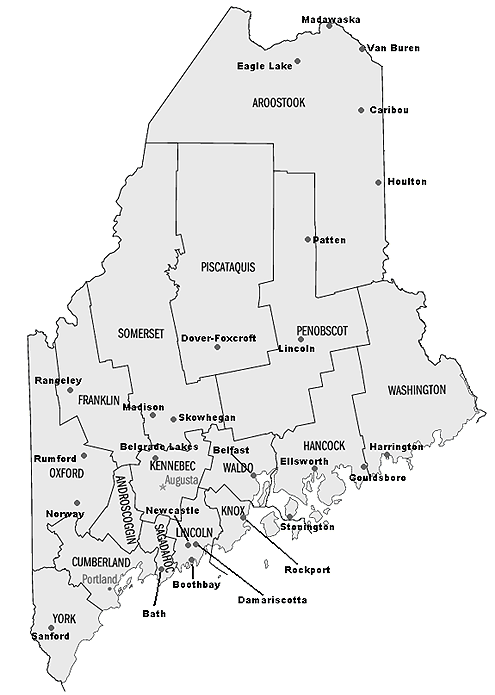
Figure 1: Maine: track orientation preceptorship sites.
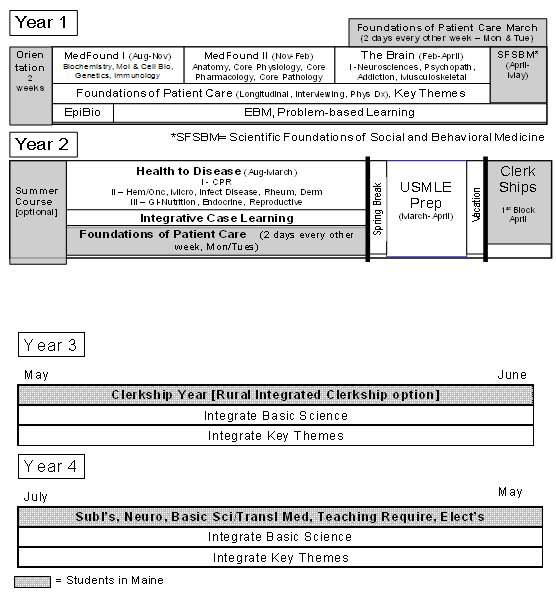
Figure 2: Schematic of 4 year program.
Early in the process, a focus on developing a distributed educational model similar to the WWAMI model was favored11, and consultation with one of the authors (TN) occurred on several occasions. Individuals involved in other partnerships between academic medical centers and medical schools were also contacted12. Besides the rural experiences taking in the orientation period and FPC course, we plan to pilot a longitudinal, integrated clerkship (LIC)13,14 in three selected community-hospital sites for a small number of students. These sites have been long-standing participants in the MPN. We believe immersing students in a rural community for high-quality education provides the appropriate context15, which may impact eventual practice choices16. Maine-Track fourth year students will also be able to select month-long rotations in Maine Practice Network sites. There is also a traditional clerkship option and an opportunity for Boston-based students to rotate to MMC in the third and fourth years. The Maine-Track program curriculum was presented and approved by the TUSM Curriculum Committee, which has oversight of the TUSM educational program.
Both campuses will support comparable academic and student affairs functions, satisfying all LCME accreditation requirements. Financial aid services, and tutoring during the first two years will be provided by TUSM. TUSM also supports a web-based learning platform called TUSK (Tufts University Sciences Knowledgebase) which students in all 4 years can access anywhere. The MMC Department of Medical Education staff provides support for the admissions and curriculum subcommittees, and will oversee and help coordinate all clinical activities in Maine. A 15 000 foot2 Simulation Center is under construction at MMC. This Center will include three high-fidelity simulation rooms, a skills laboratory, and a 10 room standardized patient center. The Simulation Center will complement similar centers at TUSM, Baystate Medical Center, and Lahey Clinic, forming a network providing training for all TUSM students. Each Maine-Track student has a Maine-based faculty advisor. An Academic Dean at MMC is responsible for oversight of the medical school program, and reports to both the Dean of TUSM and the CEO of MMC. The TUSM has successfully implemented local Academic Dean positions at several of its other major teaching affiliates.
Providing tuition support for Maine students will be a hallmark of this medical program. Leadership at both institutions has vigorously sought such support. The Governor and state legislature are enthusiastic about the program and set aside stimulus funds from the American Recovery and Reinvestment Act 2009 to partly support a new scholarship program called 'Doctors for Maine's Future'17. Strong interest and support of the program by the MMC medical staff is reflected by its decision to dedicate $500 000 to endow one 4 year scholarship. A private surgical care group in Portland has provided a similar endowment. To avoid increasing the debt burden for Maine-Track students completing the required first and second year activities in Maine, housing and transportation costs are being provided by MMC while they are in Maine.
Lessons learned
Emphasize the value of medical education
In times of economic stress, the Boards of Trustees at academic institutions may be cautious about supporting educational endeavors, which demand additional financial support. Overcoming this tendency requires particularly strong leadership to establish and repeatedly emphasize the value and benefits of having young learners immersed within an organizational culture. At MMC, the 'power of the naïve question' was often mentioned as a force in maintaining physicians' competency and in improving patient care. Describing in depth an urgency18 related to future workforce needs is an important aspect that facilitated this institutional change. Leadership at both types of institutions needs to recognize that the institution may have a civic responsibility for a much larger regional perspective.
Establish high-level governance
Immediately after the formal agreement was established, a 12 member Governance Steering Committee was formed and included equal senior administrative leadership from MMC and TUSM. The Committee is co-chaired by the CEO of MMC and the Dean of TUSM. This group has been invaluable in writing a mission statement for the program, defining policy, and resolving the minor issues that have arisen to date. The Committee meets quarterly, alternating between meeting in Portland and Boston.
Ensure face-to-face time
In this electronic age of email, instant messaging, and texting, communication can be fraught with misunderstandings. In exploring and developing a partnership of this nature, we encourage others to spend as much face-to-face time as possible. Early on MMC faculty were integrated into TUSM teaching activities (eg 3rd year student OSCEs) and committees (eg core clerkship committees and the simulation committee), providing an opportunity to work with faculty from TUSM and affiliated hospitals.
Manage internal stakeholders
Major changes can create significant anxiety amongst internal stakeholders, such as faculty, Board members, and staff19. Leadership at MMC and TUSM met early and frequently with their respective internal stakeholders to describe the process and potential merits and to hear concerns. As an example, a major all day retreat was held in Boston that allowed Maine faculty to interact with faculty from other TUSM major teaching affiliates. Underestimating the barriers a particular internal stakeholder group can create may be a difficult challenge to moving efforts forward.
Think long term
Important partnerships such as ours must have a long-term perspective as its foundation. One aspect of the success of our medical school program will not be adequately assessed for 7-10 years to come, as our Maine-Track graduates complete residency and determine practice locations. This extended investment outlook is important to emphasize with Board members approving multi-year financial strategic commitments, and other internal stakeholders. The longer view was also codified in our multi-year written agreement between MMC and TUSM
Find synergy from different strengths
All academic medical centers and medical schools have unique strengths that they each bring to the table. Fostering a partnership is not so much about changing the other party, but exploring what the differences are and seeing where such differences can provide synergistic opportunities for growth. For example, with a smaller class size in the Maine-Track, innovative changes such as the LIC can be piloted. The MMC faculty have had a direct positive effect on the TUSM Educational Strategic Plan (eg contribution of MMC patient safety and quality objectives to TUSM themes; clerkship competencies developed by MMC faculty are aiding revisions of TUSM core clerkship competencies).
Plan for contingencies
A well-thought process should plan for multiple contingencies. This includes potential short-term and long-term problem situations that may arise. Our emphasis here is preparing for problems that inevitably come up when two large organizations partner, as well as being flexible, nimble, and adaptable. Willingness to handle ongoing dynamic changes effectively is partly reflective of an institution's culture, and should be explored as one due diligence step early on.
Create a communications plan
Communicating events and processes to both internal and external stakeholders is paramount for a new partnership to develop smoothly. Leaders need to continually assume that many still have not heard the message. One of our initial steps was to host a large faculty retreat to explore curriculum possibilities20. Relying mainly on electronic medium can result in lack of needed buy-in. Communication efforts need to occur in multiple forums and media, and repeated at periodic intervals. A monthly, one-page 'Newsflash' was distributed to faculty and staff at TUSM and MMC. The TUSM Deans for Educational Affairs and Student Affairs regularly reported to the TUSM Executive Council (eg all department Chairs, local Deans, Chief Academic Officers at major teaching affiliates) and the TUSM Board of Overseers.
Address regulatory issues
Like clinical medicine, medical education is not without its regulatory and accreditation bodies. We contacted the LCME early on in our process. A consultative site visit in Portland by the two incumbent Secretariats was very helpful in clarifying LCME accreditation requirements. Certain states' Boards of Education (BOE) may also require approval of out-of-state institutions providing education within a state. The Maine BOE requested a review and approval of this medical school program.
Foster private/public collaboration
Our vision of the future of medical education includes increased collaboration between public and private institutions. The full cost of training physicians cannot fall either solely on medical schools nor academic medical centers. State government must be a partner in this endeavor, with state support depending on the local assets and resources it can bring to bear. A one-size-fits-all solution is not likely possible, but unique regional collaborations like our program can be designed.
Involve the community
We think the changing face of clinical medicine requires a stronger involvement of the rural community in medical education. Physician learners require more outpatient, longitudinally oriented experiences. The important context of community-based education does matter15. We have active plans to involve community members at multiple levels (eg increasing the interest of elementary and high school students in health care professions, participation on the admissions and curriculum subcommittees, adopt-a-family experience for medical students). Communities need to appreciate the value of medical education as well.
Learn from the mistakes and successes of others
Our collaboration with educational leaders from the University of Washington's WWAMI program allowed us to avoid some pitfalls, while adopting ideas that had been tested. As you begin an endeavor of this complexity, try to identify others who have accomplished similar activities. Contact them and seek their advice and involvement.
Tap into the excitement
The overwhelming enthusiasm for this new medical education program by MMC faculty, other physicians in all parts of Maine, learners, the state legislature, and Maine's citizens, in some respects was to be expected, as new partnerships have the potential for such excitement. For Maine physicians, however, the medical school program seems to have touched upon a strong desire to 'give back' to their profession and to return to their humanistic reasons for becoming a physician, which can be often buried and forgotten with the current demands and burdens of clinical practice. We encourage others to not underestimate the positive impact of promoting the value of educating of tomorrow's caregivers, and to tap into and grow the excitement we have witnessed with this new partnership.
References
1. US Department of Health & Human Services. Table 222. Estimated active physicians (MDS) and physician-to-population ratios by specialty group and geographic area, December 31, 2001 . (Online) 2001. Available: http://bhpr.hrsa.gov/healthworkforce (Accessed 7 May 2010).
2. Johnson KE, Larson EH. State rural health snapshots: profiles and comparisons. (Online) 2000. Available: http://depts.washington.edu/uwrhrc/uploads/RuralCh5Snapshots.2.pdf (Accessed 7 May 2010).
3. Maine Recruitment Center. Home page. (Online) 2009. Available: www.themrc.org (Accessed 5 May 2010).
4. US Census Bureau. Median family income (in 2005 inflation-adjusted dollars): 2005. (Online) 2005. Available: http://factfinder.census.gov/servlet/ThematicMapFramesetServlet?-geo_id=04000US23&-tm_name=ACS_2005_EST_G00_M01182&-ds_name=ACS_2005_EST_G00 (Accessed 7 May 2010).
5. AAMC. Table 4: Matriculants to U.S. Medical Schools by State of Legal Residence, 1998-2009. (Online) 2009. Available: http://www.aamc.org/data/facts/applicantmatriculant/table4-fact2009slrmat-web.pdf (Accessed 7 May 2010).
6. Rabinowitz HK, Diamond JJ, Markham FW, Paynter NP. Critical factors for designing programs to increase the supply and retention of rural primary care physicians. JAMA 2001; 286: 1041-1048.
7. Rosenblatt RA, Andrilla CH. The impact of U.S. medical students' debt on their choice of primary care careers: an analysis of data from the 2003 medical school graduation questionnaire. Academic Medicine 2005; 80: 815-819.
8. AAMC. Statement on the physician workforce. Washington, DC: AAMC, June 2006.
9. Levinson W, Axler H. Strategic planning in a complex academic environment: lessons from one academic health center. Academic Medicine 2007; 82: 806-811.
10. Rackleff LZ, O'Connell MT, Warren DW, Friedland ML. Establishing a regional medical campus in Southeast Florida: successes and challenges. Academic Medicine 2007; 82: 383-389.
11. Norris TE, Coombs JB, House P, Moore S, Wenrich MD, Ramsey PG. Regional solutions to the physician workforce: the WWAMI experience. Academic Medicine 2006; 81: 857-862.
12. Fishleder AJ, Henson LC, Hull AL. Cleveland Clinic Lerner College of Medicine: an innovative approach to medical education and the training of physician investigators. Academic Medicine 2007; 82: 390-396.
13. Ogur B, Hirsh D, Krupat E, Bor D. The Harvard Medical School-Cambridge integrated clerkship: an innovative model of clinical education. Academic Medicine 2007; 82: 397-404.
14. Norris TE, Schaad DC, DeWitt D, Ogur B, Hunt DD and the members of the Consortium of Longitudinal Integrated Clerkships. Longitudinal integrated clerkships for predoctoral medical students: an innovation adopted by multiple medical schools internationally Academic Medicine 2009; 84: 902-907.
15. Baron RJ. Medicine cut off from its roots: context matters in medical education. Health Affairs 2008; 27: 1357-1361.
16. Rabinowitz HK, Diamond JJ, Markham FW, Wortman JR. Medical school programs to increase the rural physician supply: a systematic review and projected impact of widespread replication. Academic Medicine 2008; 83: 235-243.
17. FAME. Doctors for Maine's future. (Online) no date. Available: http://www.famemaine.com/Files/Pages/education%5Cstudents_and_families/Maine_Financial_Aid.aspx (Accessed 7 May 2010).
18. Kotter JP. Leading change. Boston, MA: Harvard Business School Press, 1996.
19. Hughes J, Weiss J. Simple rules for making alliances work. Harvard Business Review 2007; November: 22-131.
20. Loeser H, O'Sullivan P, Irby DM. Leadership lessons from curricular change at the University of Southern California, San Francisco, School of Medicine. Academic Medicine 2007; 82: 324-330.
